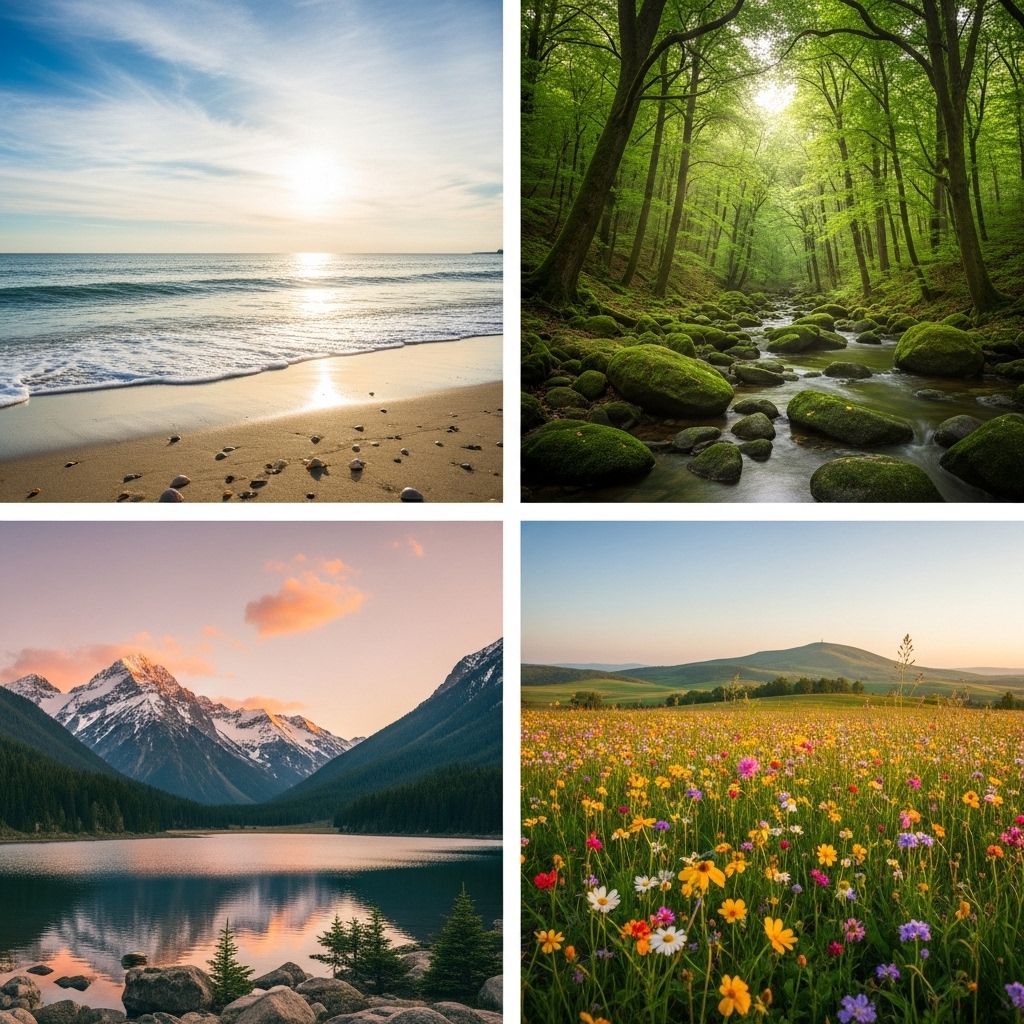Guided Imagery Scripts Featuring Natural Landscapes
Scenic views of forests, beaches, and starry skies calm the mind and promote peace.

Guided imagery is a powerful tool for relaxation and stress reduction, utilizing vivid descriptions of natural landscapes to transport you to a state of serenity and tranquility. This technique leverages the mind’s ability to visualize and engage with peaceful environments, providing a mental escape from the stresses of daily life. In this article, we will delve into the world of guided imagery scripts featuring natural landscapes, exploring their benefits, common themes, and how to incorporate them into your mindfulness practice.
Benefits of Guided Imagery
Reducing Stress and Anxiety
Guided imagery has been recognized for its ability to significantly reduce stress and anxiety by creating a mental environment that promotes relaxation and calmness. By immersing yourself in serene natural settings, you can lower cortisol levels and improve overall well-being.
Improving Sleep Quality
For those struggling with sleep, guided imagery can be a valuable tool. Visualizing peaceful landscapes before bed can help calm the mind and body, leading to better sleep quality and duration.
Enhancing Focus and Concentration
Regular practice of guided imagery can improve focus and concentration by training the mind to settle into a peaceful state, enhancing mental clarity and productivity.
Common Natural Landscapes in Guided Imagery
Guided imagery scripts often feature a variety of natural landscapes, each designed to evoke a specific emotional response or state of mind. These include:
- Beaches: Imagining a serene beach with gentle waves and warm sand can evoke feelings of relaxation and peace. The sound of the waves and the warmth of the sun on your skin create a soothing atmosphere that calms the mind and body.
- Forests: Forests are a popular choice for guided imagery, offering the tranquility of greenery, the sound of leaves rustling, and the scent of earthy moss. These elements combine to create a grounding experience that reduces stress and promotes relaxation.
- Mountains: Visualizing mountain landscapes can evoke a sense of grandeur and awe while offering a panoramic view of tranquility. The imagery often includes elements like crisp mountain air and the sound of wind whispering through trees.
- Starry Skies: Gazing at a starry night sky can inspire feelings of wonder and connection to the universe. This setting is used to promote a sense of calm and perspective.
Creating Your Own Guided Imagery Scripts
While many guided imagery scripts are available, you can also create your own personalized scripts based on your favorite natural landscapes. Here are some tips to help you craft effective scripts:
- Choose a Setting: Select a natural setting that resonates with you, such as a beach, forest, or mountain range.
- Use Vivid Descriptions: Employ sensory language to describe what you see, hear, feel, and smell in your chosen environment. This helps the listener immerse themselves fully in the scene.
- Encourage Relaxation: Guide the listener to relax further by suggesting deep breathing and the release of tension.
- Provide a Closure: End your script with a gentle awakening or transition back to the present moment, ensuring the listener feels refreshed and relaxed.
Example Guided Imagery Scripts
Beach Relaxation Script
Imagine yourself standing on a serene beach at dawn. Feel the cool sand beneath your feet and the gentle ocean breeze rustling your hair. Listen to the rhythmic sound of waves gently lapping at the shore. As you breathe in, smell the salty air filling your lungs. Now, visualize the sun rising slowly over the horizon, casting a warm glow across the sky.
Allow yourself to relax further with each breath, letting go of any tension or worries. Feel the warmth of the sun on your skin and the peace that comes with being in nature.
Forest Sanctuary Script
Envision walking through a tranquil forest, surrounded by towering trees and lush greenery. Notice the sound of leaves rustling in the wind and the scent of earthy moss beneath your feet. As you walk, the trees seem to close in around you, creating a sense of safety and protection.
Feel the coolness of the forest air on your skin and the peace that comes from being immersed in nature. Allow yourself to let go of any stress or anxiety, feeling grounded and at peace.
Table of Contents
- Benefits of Guided Imagery
- Common Natural Landscapes in Guided Imagery
- Creating Your Own Guided Imagery Scripts
- Example Guided Imagery Scripts
Frequently Asked Questions (FAQs)
Q: How Often Should I Practice Guided Imagery?
A: It is recommended to practice guided imagery regularly, ideally daily, to experience consistent benefits in relaxation and stress reduction.
Q: Can I Use Guided Imagery to Improve Sleep Quality?
A: Yes, guided imagery can be used before bed to enhance sleep quality by creating a peaceful mindset and reducing stress.
Q: How Do I Create a Personalized Guided Imagery Script?
A: Start by choosing a natural setting that resonates with you, then use vivid sensory descriptions to create an immersive experience. Guide the listener to relax and let go of tension, ending with a gentle closure.
References
- https://www.michaeljemery.com/guided-imagery/relaxation-oasis-free-guided-imagery-scripts/
- https://www.innerhealthstudio.com/visualization-scripts.html
- https://mindremakeproject.org/2024/02/07/forest-guided-meditation/
- https://mindfulnessexercises.com/outdoor-meditation/
- https://ambujayoga.com/blog/yoga-nidra-script-inspired-by-nature/
- https://positivepsychology.com/guided-imagery-scripts/
- https://beyourownsunshinee.ca/2021/12/06/rainy-day-guided-visualization/
- https://www.youtube.com/watch?v=_ZeEPo8w-n8
- https://www.meditationoasis.com/how-to-meditate/simple-meditations/nature-meditations
- https://thesanfordschool.asu.edu/sites/g/files/litvpz486/files/2022-07/Mindfulness%20Scripts_Combined.pdf
Read full bio of medha deb












